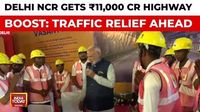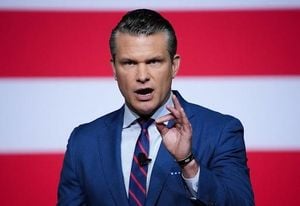Delhi’s traffic woes have long been the stuff of local legend—snarled intersections, honking horns, and, in recent years, a sudden proliferation of e-rickshaws weaving through the chaos. But on August 17, 2025, Prime Minister Narendra Modi sought to flip the script, inaugurating two massive highway projects worth a staggering Rs 11,000 crore, designed to untangle the capital’s notorious gridlock and give residents a much-needed breath of fresh air.
According to News18, the two new arteries—the Delhi section of the Dwarka Expressway and the Urban Extension Road-II (UER-II)—are more than just stretches of asphalt. They’re the centerpiece of a comprehensive strategy to bring world-class infrastructure to India’s capital, promising not only to cut travel times but to fundamentally change the way Delhiites move around their city. "This highway will now save everyone’s time. The whole world is witnessing the resolve of our nation," Prime Minister Modi said at the launch, his words echoing across a crowd that had gathered for a vibrant roadshow, complete with cheers and slogans of support.
The numbers are impressive. The 10.1-kilometer Dwarka Expressway section, developed at a cost of around Rs 5,360 crore, includes a 5.9 km stretch from Shiv Murti intersection to the Road Under Bridge at Dwarka Sector-21, and another 4.2 km from there to the Delhi-Haryana border. These new links offer direct connectivity to the UER-II, which itself is designed to serve as a major bypass for the capital. The projects are expected to provide multi-modal connections to key locations such as Yashobhoomi, the DMRC Blue and Orange Metro lines, the upcoming Bijwasan railway station, and the Dwarka cluster bus depot, according to the official statement from the Prime Minister’s Office.
But perhaps the most striking promise is the projected reduction in travel time. A journey from the Dwarka Expressway to the Singhu border, which once took up to three hours, is now expected to take just 40 minutes. As The Economic Times reports, these new highways are also expected to reduce the daily entry of approximately 300,000 vehicles into Delhi, a move that could significantly curb pollution and congestion. In a city where smoggy skies and marathon commutes are all too common, that’s no small feat.
There’s another, quieter benefit: the construction of these highways made innovative use of waste from the Ghazipur and Bhalswa landfills, a nod to environmental responsibility in a city grappling with mountains of garbage. For a metropolis that’s often in the headlines for its environmental challenges, this repurposing of landfill waste adds a much-needed green angle to the infrastructure blitz.
Yet even as Delhi celebrates these new expressways, another challenge has been steadily growing on its streets: the rapid, sometimes chaotic rise of e-rickshaws. According to The Economic Times, traffic violations by e-rickshaw drivers have tripled in just two years, with improper parking topping the list of offenses—over 25,000 notices were issued in 2025 alone for this infraction. Other common violations include driving on the wrong side of the road (1,607 notices in 2025) and no-entry violations, which shot up from 25,986 in 2024 to a staggering 41,394 in 2025. Driving without a license and allowing unauthorized persons to drive also rank among the top five offenses.
While e-rickshaws are undeniably crucial for last-mile connectivity—ferrying passengers from metro stations and markets to their homes—their unchecked proliferation has left many residents and officials frustrated. "The situation is extremely bad in my area, and the most discouraging part is that it is getting worse every day. There is no traffic management here. The e‑rickshaws park improperly wherever they find space. Other vehicles don’t get space to move on the road due to the e‑rickshaws. The number of e‑rickshaws should be capped in the locality," Karan Aggarwal from East of Kailash told The Economic Times. Social media is awash with similar laments, with one user posting, "Entire Delhi has been taken over by erickshaw vala @dtptraffic is totally failed to control this."
The stakes are high—not just for traffic flow, but for public safety. Fatal accidents involving e-rickshaws have risen sharply, from 11 in 2024 to 17 by July 2025. This surge has prompted experts to call for stricter planning and better enforcement. Dr. S Velmurugan, chief scientist and head of traffic engineering and safety at the Central Road Research Institute, explained, "They seem to be increasing by the day. They should only operate on collector roads, not on arterial roads." He emphasized that many metro lines run along arterial roads, drawing e-rickshaws to these busy stretches and leaving just one lane for other motorists—an arrangement that simply isn’t sustainable.
It’s not as if authorities haven’t tried to rein in the chaos. Back in September 2014, the Delhi High Court declared unregistered e-rickshaws illegal and prompted a transport department notification banning their movement and idle parking on 236 road stretches. The Public Works Department was tasked with installing warning signboards in these restricted zones, but as The Economic Times notes, many of those signs are now missing, and enforcement appears to have waned. "Even though in the past the transport department made many claims about having brought the e‑rickshaw menace under control," the article observed, "officials did not respond to TOI’s questions on the matter this time."
So, what’s the path forward for a city caught between rapid modernization and unruly street-level realities? Experts suggest a two-pronged approach: designate specific stands for e-rickshaws and cap their numbers in congested areas, while ensuring these vehicles operate only on collector roads. Meanwhile, the new highways are expected to provide some much-needed relief, diverting long-distance traffic away from the city’s already crowded arterial routes and freeing up space for local movement—if, of course, the rules are enforced and all players stick to their lanes.
At the inauguration, Delhi Chief Minister Rekha Gupta and Haryana Chief Minister Nayab Singh Saini joined Prime Minister Modi and Union Minister Nitin Gadkari in celebrating what they described as a new chapter for the capital. PM Modi, never one to shy away from grand ambitions, declared, "We have to make Delhi such a model of development, where everyone feels that yes, this is the capital of a developing India."
For now, Delhi stands at a crossroads—literally and figuratively. The new highways promise smoother rides and cleaner air, but the city’s ongoing tussle with e-rickshaw chaos is a reminder that infrastructure alone isn’t enough. It’ll take careful planning, vigilant enforcement, and a willingness to adapt as the city grows. But for millions of commuters, the hope is simple: a safer, quicker, and less stressful journey home.




